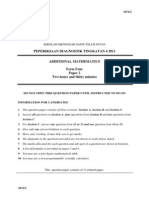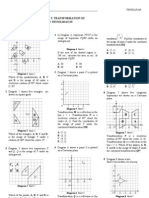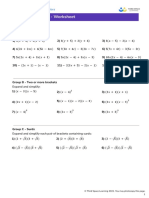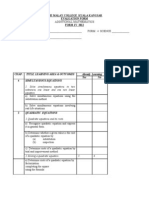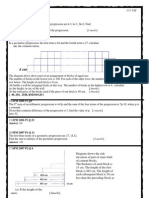Past Year Questions
Past Year Questions
Uploaded by
ke2Copyright:
Available Formats
Past Year Questions
Past Year Questions
Uploaded by
ke2Original Description:
Copyright
Available Formats
Share this document
Did you find this document useful?
Is this content inappropriate?
Copyright:
Available Formats
Past Year Questions
Past Year Questions
Uploaded by
ke2Copyright:
Available Formats
PIPA(8)
Past year questions
1.SPM 2003 P1Q7
The first three terms of an arithmetic progression are k-3, k+3, 2k+2. Find
a) the value of k
b) the sum of the first 9 terms of the progression.
[3 marks]
[ans: 7, 252]
2.SPM 2003 P1Q8
In a geometric progression, the first term is 64 and the fourth term is 27. calculate
(a) the common ration,
(b) the sum to infinity of the geometric progression.
[4 marks]
[ans: , 256]
3.SPM 2004 P1Q9
Given a geometric progression y,2,
4
,p, express p in terms of y. [2 marks]
y
[ans: p= 8/y2 ]
4.SPM 2004 P1 Q 10
Given an arithmetic progression -7, -3, 1, , state three consecutive terms in this progression
which sum up to 75.
[3 marks]
[ans: 29, 25, 21 ]
5. SPM 2004 P1 Q 11
The volume of water in a tank is 450 litres on the first day. Subsequently, 10 litres of water is
added to the tank everyday. Calculate the volume, in litres. Of water in the tank at the end of the
7th day.
[2 marks]
[ans : 510]
6.SPM 2004 P1Q12
Express the recurring decimal 0.969696 as a fraction in its simplest form. [4 marks]
[ans : 32/33]
7.SPM 2004 P2 Q6
Diagram below shows the arrangement of the first three of an infinite series of similar triangles.
The first triangle has a base of x cm and a height of y cm. the measurements of the base and
height of each subsequent triangle are half of the measurements of its previous one.
(a) Show that the area of the triangles form a
geometric progression and state the common ratio .
[3 marks]
(b) Given that x=80 cm and y=40 cm,
1
4
2
(i) determine which triangle has an area of 6 cm .
(ii) find the sum to infinity of the area, in cm2, of the
triangles.
[5 marks]
[ans: , n=5, 2133 1/3 ]
PIPA(8)
8.SPM 2005 P1 Q 10
The first three terms of a sequence are 2, x, 8. Find the positive value of x so that the sequence is
(a) an arithmetic progression
(b) a geometric progression.
[2 marks]
[ans:5,4]
9. SPM 2005 P1 Q 11
The first three terms of an arithmetic progression are 5, 9, 13. Find
(a) the common difference of the progression,
(b) the sum of the first 20 terms after the 3rd term.
[ans:4, 1100]
[4 marks]
10.SPM 2005 P1 Q 12
The sum of the first n terms of the geometric progression 8, 24, 72, is 8744. Find
(a) the common ration of the progression
(b) the value of n
[4 marks]
[ans: 3, 7 ]
11. SPM 2005 P2 Q 3
The diagram above shows part of an arrangement of bricks of equal size.
The number of bricks in the lowest row is 100. For each of the other rows, the number of bricks is
2 less than in the row below. The height of each brick is 6 cm.
Ali builds a wall by arranging bricks in this way. The number of bricks in the highest row is 4 ,
calculate
(a) the height, in cm, of the wall.
[3marks]
(b) the total price of the bricks used if the price of one brick is 40 sen. [3marks]
[ 49, 294, 2548, RM1019.20 ]
12.SPM 2006 P1 Q9
The 9th term of an arithmetic progression is 4+5p and the sum of the four terms of the progression
is 7p-10, where p is a constant.
Given that common difference of the progression is 5, find the value of p. [3 marks]
[ans: 8]
PIPA(8)
13.SPM 2006 P1 Q 10
The third term of a geometric progression is 16. The sum of the third term and the fourth term is
8. Find
(a) the first term and the common ratio of the progression.
(b) The sum to infinity of the progression.
[4 marks]
[ans: 64, 42 2/3 ]
14.SPM 2007 P1 Q9
(a) determine whether the following sequence is an arithmetic progression or a geometric
progression.
(b) Give a reason for the answer in part (a)
[2 marks]
Answer :GP, the raio of two consecutive terms of the sequence is a constant
15 SPM 2007 P1 Q10
Three consecutive terms of an arithmetic progression are 5-x, 8, 2x.
Find the common difference of the progression.
[3 marks]
Answer :14
16 SPM 2007 P1 Q 11
The first three terms of a geometric progression are 27, 18,12.
Find the sum to infinity of the geometric progression.
[3 marks]
Answer : 81
17.SPM 2007 P2 Q 6
Diagram shows the side elevation
of part of stairs built of cement
blocks.
The thickness of each block is 15
cm. The length of the first block is
985 cm. The length of each
subsequent block is 30 cm less
than the preceding block as shown
in the diagram.
(a) If the height of the stairs to be built is 3 m, calculate
(i)
the length of the top most block
(ii)
the total length of the blocks.
(b) calculate the maximum height of the stairs
[5marks]
[3marks]
Answer : 415, 14000, 495
18 SPM 2008 P1 Q9
It is given that the first four terms of a geometric progression are 3, -6, 12 and x. Find the value of
x.
[2marks]
[ ans -24 ]
19. SPM 2008 P1 Q10
The first three terms of an arithmetic progression are 46, 43 and 40. the nth term of this
progression is negative. Find the least value of n.
[3marks]
[ans 17]
PIPA(8)
20 SPM 2008 P1 Q 11
In a geometric progression, the first term is 4 and the common ratio is r. Given that the sum to
infinity of this progression is 16, find the value of r.
[2marks]
[ ans : ]
21. SPM 2008 P2Q3
Muthu started working for a company on 1 January 2002 with an initial annual salary of
RM18,000. Every January, the company increased his salary by 5% of the previous years salary.
Calculate
(a) his annual salary, to the nearest RM, for the year 2007
[3marks]
(b) the minimum value of n such that his annual salary in the nth year will exceed RM36,000
[2marks]
(c) the total salary, to the nearest RM, paid to him by the company, for the years 2002 to 2007.
[2marks]
You might also like
- Name: Date: Class: Instruction: For Each of The Questions 1 To 50, Choose The Correct Answer For Each Question From The Four Options A, B, C and DDocument7 pagesName: Date: Class: Instruction: For Each of The Questions 1 To 50, Choose The Correct Answer For Each Question From The Four Options A, B, C and Dke2100% (2)
- ADD MATHS Progressions FORM 5Document6 pagesADD MATHS Progressions FORM 5Cik NursharwaniNo ratings yet
- f4 Form 4 March Test NewDocument8 pagesf4 Form 4 March Test NewHengLowNo ratings yet
- Topic 4 MoneyDocument20 pagesTopic 4 MoneyputrlaNo ratings yet
- MODULE 14 Algebraic Exp Expand Factor Is at IonDocument6 pagesMODULE 14 Algebraic Exp Expand Factor Is at IonNyai Blorong KetombeNo ratings yet
- Tutorial PROB1 - Permutations and Combinations - 2013 v3 (QED Solutions)Document8 pagesTutorial PROB1 - Permutations and Combinations - 2013 v3 (QED Solutions)Indrik WijayaNo ratings yet
- Answer All Question in This SectionDocument12 pagesAnswer All Question in This SectionSaifulAhmadNo ratings yet
- Math PT3 Revision 1 2 3Document5 pagesMath PT3 Revision 1 2 3Noor Fazliati SulaimanNo ratings yet
- Matematik - Tingkatan 1Document35 pagesMatematik - Tingkatan 1Sekolah Portal96% (52)
- Additional Mathematics Chapter 6 Coordinate GeometryDocument4 pagesAdditional Mathematics Chapter 6 Coordinate GeometryRaymondNo ratings yet
- Chapter 6 - Coordinate GeometryDocument19 pagesChapter 6 - Coordinate GeometryshahrulkamilNo ratings yet
- Final Form 4 2011 (Soalan Dan Skema), Peperiksaan Akhir Tahun Tingkatan 4 2011Document22 pagesFinal Form 4 2011 (Soalan Dan Skema), Peperiksaan Akhir Tahun Tingkatan 4 2011Rohaya Morat60% (5)
- SPM Form 4 Add Math Revision Note - Differentiation 3Document6 pagesSPM Form 4 Add Math Revision Note - Differentiation 3MyHomeTuition.com50% (4)
- Form 5 MathematicsDocument10 pagesForm 5 MathematicslimsiewthiangNo ratings yet
- Form 2 - Chapter 13Document8 pagesForm 2 - Chapter 13Adibah AliasNo ratings yet
- F2 - Rumus AlgebraDocument4 pagesF2 - Rumus AlgebraQaisara LailaNo ratings yet
- Form 1 Chapter 2 Number Patterns and SequencesDocument4 pagesForm 1 Chapter 2 Number Patterns and SequencesKarmen ThumNo ratings yet
- Jom Tanya Sifu :15 Days Programme Part 1Document15 pagesJom Tanya Sifu :15 Days Programme Part 1Hayati Aini AhmadNo ratings yet
- Add Maths F4 Topical Test 5 (BL)Document3 pagesAdd Maths F4 Topical Test 5 (BL)hanifah100% (1)
- Linear Law P1Document2 pagesLinear Law P1mohamad_bidari0% (1)
- M013-Consumer Mathematics (Taxation)Document5 pagesM013-Consumer Mathematics (Taxation)Tan Jun You100% (1)
- Formula Addmath SPM KSSMDocument1 pageFormula Addmath SPM KSSMMasrupawan AsmaranyNo ratings yet
- Modul 1 Persamaan Linear SerentakDocument5 pagesModul 1 Persamaan Linear SerentakPing Ping ThianNo ratings yet
- Quiz 1 Mathematics Form 4Document1 pageQuiz 1 Mathematics Form 4Suryani AdamNo ratings yet
- Formulae: Mathematics Form 2 Standardised Test 1: Circles Duration: 30 MinutesDocument4 pagesFormulae: Mathematics Form 2 Standardised Test 1: Circles Duration: 30 MinutesemiliaroslanNo ratings yet
- Chap 01Document4 pagesChap 01Jamaliah Daud76% (33)
- Revision Module Midterm Maths Form 5Document19 pagesRevision Module Midterm Maths Form 5Lyna NaderNo ratings yet
- Additional Mathematics SPM Form 4 Chapter 7 StatisticsDocument23 pagesAdditional Mathematics SPM Form 4 Chapter 7 StatisticsNiceman NatiqiNo ratings yet
- Form 4 Geometry CoordinateDocument13 pagesForm 4 Geometry CoordinateVaidehi UlaganathanNo ratings yet
- Solid Geometry ExerciseDocument14 pagesSolid Geometry ExerciseRishwin Singh SindaNo ratings yet
- MODULE 13 - Gradient and Area Under A GraphDocument12 pagesMODULE 13 - Gradient and Area Under A GraphhasnitajbNo ratings yet
- AMATH DifferentiationDocument16 pagesAMATH DifferentiationLeneNo ratings yet
- 1 Functions: Questions Based On SPM FormatDocument3 pages1 Functions: Questions Based On SPM FormatAmri AwalludinNo ratings yet
- Matematik K1 Trial SPM SBP 2019Document28 pagesMatematik K1 Trial SPM SBP 2019Fendi A. Bakar75% (4)
- FORM 4 Additional Mathematics MODULE 1Document2 pagesFORM 4 Additional Mathematics MODULE 1ALAN LIEW KOK PINNo ratings yet
- Third Space Learning Expand and Simplify GCSE WorksheetDocument8 pagesThird Space Learning Expand and Simplify GCSE WorksheetOdette KirstenNo ratings yet
- Topic 6 PolynomialDocument4 pagesTopic 6 PolynomialWan AziahNo ratings yet
- 2018 Maths Trial Paper 1 PDFDocument10 pages2018 Maths Trial Paper 1 PDFChin VennNo ratings yet
- Revision Practise SurdDocument7 pagesRevision Practise SurdyslnjuNo ratings yet
- Mid Year Add Maths Form 5 Paper 1Document11 pagesMid Year Add Maths Form 5 Paper 1Rofi HussainNo ratings yet
- Sets (Form 4)Document6 pagesSets (Form 4)Wan KhairinaNo ratings yet
- Kertas 1 Maths Form4 2023 PEP 3Document18 pagesKertas 1 Maths Form4 2023 PEP 3ANNA SHU NGIIK YNG MoeNo ratings yet
- 2012 Math F2 (Directed Numbers)Document1 page2012 Math F2 (Directed Numbers)compeil100% (1)
- Add Maths Form 4Document10 pagesAdd Maths Form 4Azrul AkmarNo ratings yet
- Physics: Form 4 Theme 2 Newtonian MechanicsDocument22 pagesPhysics: Form 4 Theme 2 Newtonian MechanicsYogaraajaa Seemaraja100% (1)
- Math F2 Ujian 3 K1Document4 pagesMath F2 Ujian 3 K1compeilNo ratings yet
- Objektif 1 2009Document10 pagesObjektif 1 2009Aina20No ratings yet
- Circular Measure Past YrDocument3 pagesCircular Measure Past YrpizamNo ratings yet
- Jom Skor A+ Fizik: Quantum PhysicsDocument7 pagesJom Skor A+ Fizik: Quantum Physicsmrsm fizikNo ratings yet
- Progression Past YearDocument2 pagesProgression Past YearMrJay SuperNo ratings yet
- Koleksi Soalan SPM Add MathsDocument17 pagesKoleksi Soalan SPM Add MathsCheegu EmmaNo ratings yet
- AddMaths Form 5 CHP 1 Arithmetic ProgressionDocument5 pagesAddMaths Form 5 CHP 1 Arithmetic ProgressionbidarihassanNo ratings yet
- Additional Mathematics SMK Triang 3 Assessment Test 1 2010 Name: Form: Section A: Answer All Questions in The Space ProvidedDocument4 pagesAdditional Mathematics SMK Triang 3 Assessment Test 1 2010 Name: Form: Section A: Answer All Questions in The Space Providedenniez30No ratings yet
- Koleksi Soalan SPM Paper 2Document37 pagesKoleksi Soalan SPM Paper 2onkyohassanNo ratings yet
- Koleksi Soalan SPM Paper 2Document37 pagesKoleksi Soalan SPM Paper 2Kaness MathzNo ratings yet
- C CCCDocument3 pagesC CCCEchah HamidNo ratings yet
- Modul Matematik Tambahan Form 5 (JPNP)Document110 pagesModul Matematik Tambahan Form 5 (JPNP)Fazlina Mustafa0% (1)
- 2024 Exam MathsDocument116 pages2024 Exam Mathslakshamanagowda151No ratings yet
- Addition Mathematic Form 5 Progression Module 1Document15 pagesAddition Mathematic Form 5 Progression Module 1Umaish NairNo ratings yet
- ProgressionDocument38 pagesProgressionNisa Hj MohamadNo ratings yet
- f5 Am c1 Geometric ProgressionDocument14 pagesf5 Am c1 Geometric ProgressionKarmen ThumNo ratings yet
- Add-Maths ProjectDocument14 pagesAdd-Maths Projectke2No ratings yet
- Add-Maths ProjectDocument14 pagesAdd-Maths Projectke2No ratings yet
- Name: Date: Class: Instruction: For Each of The Questions 1 To 30, Choose The Correct Answer For Each Question From The Four Options A, B, C and DDocument4 pagesName: Date: Class: Instruction: For Each of The Questions 1 To 30, Choose The Correct Answer For Each Question From The Four Options A, B, C and Dke2No ratings yet
- Novel Catch Us If You CanDocument25 pagesNovel Catch Us If You Canke2No ratings yet
- Biology Practical Reports For Form 4 Activity 8.6 (Practical Textbook Page 113)Document2 pagesBiology Practical Reports For Form 4 Activity 8.6 (Practical Textbook Page 113)ke2No ratings yet
- D Biology: Nama Pelajar: Kelas: MarkahDocument6 pagesD Biology: Nama Pelajar: Kelas: Markahke2No ratings yet
- C D A B C D Biology Assessment TestDocument4 pagesC D A B C D Biology Assessment Testke2No ratings yet
- Biology Practical Reports For Form 4 Activity 8.8 (Practical Textbook Page 115)Document2 pagesBiology Practical Reports For Form 4 Activity 8.8 (Practical Textbook Page 115)ke2No ratings yet
- A B C D Biology: Nama Pelajar: Kelas: MarkahDocument4 pagesA B C D Biology: Nama Pelajar: Kelas: Markahke2No ratings yet
- Biology Practical Reports For Form 4 Experiment 8.11 (Practical Textbook Page 119)Document2 pagesBiology Practical Reports For Form 4 Experiment 8.11 (Practical Textbook Page 119)ke2No ratings yet
- Biology Practical Reports For Form 4 Activity 8.5 (Practical Textbook Page 111)Document2 pagesBiology Practical Reports For Form 4 Activity 8.5 (Practical Textbook Page 111)ke2No ratings yet
- Biology Practical Reports For Form 4 Experiment 9.2 (Practical Textbook Page 128)Document2 pagesBiology Practical Reports For Form 4 Experiment 9.2 (Practical Textbook Page 128)ke20% (1)
- Biology: Nama Pelajar: Kelas: MarkahDocument4 pagesBiology: Nama Pelajar: Kelas: Markahke2No ratings yet
- Biology Practical Reports For Form 4 Experiment 8.3 (Practical Textbook Page 108)Document2 pagesBiology Practical Reports For Form 4 Experiment 8.3 (Practical Textbook Page 108)ke2100% (1)
- Biology F4Chapter 6 (Ver1)Document4 pagesBiology F4Chapter 6 (Ver1)ke2No ratings yet
- D Biology: Nama Pelajar: Kelas: MarkahDocument5 pagesD Biology: Nama Pelajar: Kelas: Markahke2No ratings yet
- Name: Date: Class: Instruction: For Each of The Questions 1 To 30, Choose The Correct Answer For Each Question From The Four Options A, B, C and DDocument5 pagesName: Date: Class: Instruction: For Each of The Questions 1 To 30, Choose The Correct Answer For Each Question From The Four Options A, B, C and Dke2No ratings yet
- Name: Date: Class: Instruction: For Each of The Questions 1 To 30, Choose The Correct Answer For Each Question From The Four Options A, B, C and DDocument4 pagesName: Date: Class: Instruction: For Each of The Questions 1 To 30, Choose The Correct Answer For Each Question From The Four Options A, B, C and Dke2No ratings yet
- Name: Date: Class: Instruction: For Each of The Questions 1 To 30, Choose The Correct Answer For Each Question From The Four Options A, B, C and DDocument4 pagesName: Date: Class: Instruction: For Each of The Questions 1 To 30, Choose The Correct Answer For Each Question From The Four Options A, B, C and Dke2100% (1)
- Biology Practical Reports For Form 4 Experiment 3.6 (Practical Textbook Page 30)Document2 pagesBiology Practical Reports For Form 4 Experiment 3.6 (Practical Textbook Page 30)ke250% (2)
- Biology Practical Reports For Form 4 Experiment 3.1 (Practical Textbook Page 20)Document2 pagesBiology Practical Reports For Form 4 Experiment 3.1 (Practical Textbook Page 20)ke267% (3)











